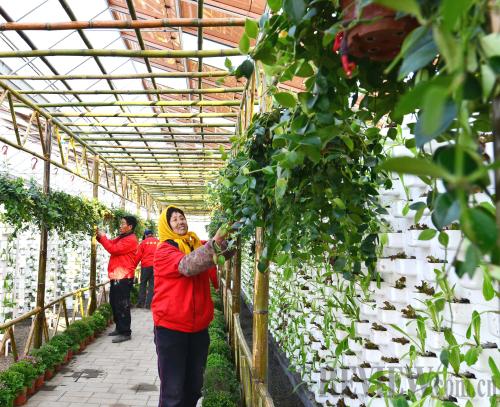|
 |
|
SOLAR TOWN: Farmers in Jimo, east China's Shandong Province, grow vegetables in a greenhouse run on solar energy, illustrating China's recent actions to protect the environment (NING YOUPENG) |
Just as the world expressed concern over the future of the Chinese economy, the Central Government once again accelerated its plans for economic reforms. At a meeting headed by Premier Li Keqiang on May 6, the State Council decided to strengthen reforms with regards to taxation, investment and financing, price controls and balanced development between urban and rural areas. The cabinet issued some measures on economic reforms involving exchange and interest rates and an operational program to make the yuan more convertible under the capital account.
According to a report by the Xinhua News Agency, Li said at the meeting that under current conditions, it is imperative to take pragmatic moves to deepen reforms in order to foster an "upgraded version" of the economy.
The previous cabinet once made a comprehensive plan on economic reforms, and some of the measures have been implemented, such as restructuring the economy and transforming the economic growth model. However, after the 2008 global financial crisis, many reform measures were suspended in the name of economic recovery and ensuring growth.
China, as the fastest-recovering economy following the global financial crisis, has not reached solid ground. In the first quarter, China's economic growth dropped slightly, and growth for the second quarter isn't expected to be stellar. According to figures from the National Bureau of Statistics (NBS), the purchasing manager index continued to drop in April, recording a monthly decline of 0.3 percentage points to stand at 50.6 percent, lower than market expectations. The numbers indicate that the overall economic recovery remains weak.
Xu Hongcai, Deputy Director of the Department of Information at the China Center for International Economic Exchanges, said that under such conditions, it has been a common understanding in China that reform must be taken to invigorate the economy.
Problems
China's previous economic growth was achieved at a cost to the environment.
According to Xu, the imbalanced, uncoordinated and unsustainable economic development can be summed up in four ways. In terms of expenditure, China's investment, consumption and net exports have faced serious imbalance during the past decade. From 2003 to 2011, about 50 percent of the country's annual GDP growth was driven by investment, while consumption was inadequate. Particularly, private consumption contributed little to the GDP, with the proportion dropping from 46.4 percent in 2000 to 33.8 percent in 2010.
In terms of production, China's industrial structure has seen uncoordinated development during the past decade. As urbanization and industrialization advance, the proportion of agriculture in terms of the GDP continues to decline. Between 2002 and 2008, the proportion of manufacturing and construction industries grew from 44.8 percent to 47.4 percent. However, the proportion of the service industry—which is less energy-consuming and labor-intensive—dropped from 41.5 percent in 2002 to 40.9 percent in 2006. The proportion resumed growth after 2009, reaching 43 percent.
Wealth distribution and income disparity continue to be an almost intractable problem. The proportion of salaried incomes continued declining between 1995 and 2007, from 52.16 percent to 39.74 percent. The proportion of disposable income declined even faster, from 65 percent in 2002 to 57 percent in 2008. The proportion of corporate income remained stable and rose slightly after 2008. In comparison, the proportion of government revenue increased rapidly. In 2008, government revenue accounted for only 17.52 percent but rose to 21.28 percent soon after.
Furthermore, China's total savings have grown compared to domestic investment during the past decade. Particularly in 2007 and 2008, the domestic savings ratio reached 53 percent of the GDP, with a surplus under the current account at a record high of 9.6 percent of the GDP.
Xu said China's pricing schemes with regards to interest rates, exchange rates and resources are being reformed, but the reform is far from complete. A contorted market has transmitted and fostered a contorted economic structure. To remedy this, it is not enough to rely solely on the economy itself. Excessive government intervention in market performance must be corrected, and a discussion is needed on the limit of government functions.
|
